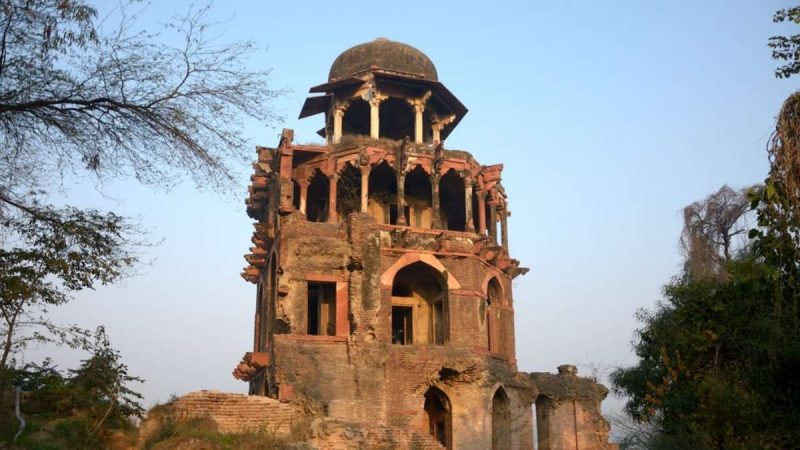Amid the bustling streets of Agra, known worldwide for its majestic Taj Mahal, lies a lesser-known historical marvel—Battis Khamba, meaning “thirty-two pillars” in Hindi. Located on the side of an old Mughal garden, this tall tower remains hidden in plain sight, an overlooked gem.
About Battis Khamba
Buland Bagh is a garden nestled on the banks of the Yamuna River. It is rich with remnants of the Mughal era and located just north of Ram Bagh. The ruins of ancient structures are scattered throughout the garden, including Chhatris and a prominent tower known as Battis Khamba. Though significant, the tower is often overlooked, hidden among overgrown shrubs and the other crumbling remains of this once-grand Mughal site.
The most striking structure in Buland Bagh is the five-story tower, locally known as Battis Khamba, supported by thirty-two pillars. The tower has intricate carvings featuring floral and geometric designs. Sadly, the once-grand Mughal garden’s other architectural features—stone pathways, water channels, tanks, cascades, and fountains—have been plundered over time. Now, it looks like the remnants of a forgotten village.
Though hidden behind the passage of time and the creeping hands of nature, Battis Khamba is a striking piece of Mughal architecture. Despite its beauty, the time has not been kind to Battis Khamba. The garden that once surrounded it lies in ruins, with thick overgrowth covering what was once a meticulously planned space. The tower itself shows signs of wear, with weathered stone and crumbling details. Yet, even in its semi-decay state, the structure evokes a sense of nostalgia.
Back Then…
The tower, constructed from red sandstone, features 36 pillars supporting an octagonal cupola. Its arched galleries add to its grandeur, with 24 columns on the fourth floor and a cupola resting on eight slender shafts on the fifth. Adjacent to the Battis Khamba is the Ram Bagh, also known as Aram Bagh or the “Garden of Rest.” This historic site has brick masonry embankments along the river, seven wells on its northern side known as Sat-Kuian, and a three-story tower called Battis Khamba. The surviving ruins stand as a testament to the architectural brilliance of the Mughal era.
Its weathered stones tell a story of a time when Agra was at the heart of one of the world’s most powerful empires, and it reminds us that even the most overlooked structures have tales worth uncovering.
So, when are you going to this historic place?
Cover image credits: Flickr

